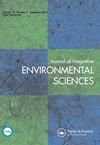驱动南非大陆表面臭氧变率因素的统计分析
IF 3.5
4区 环境科学与生态学
Q3 ENVIRONMENTAL SCIENCES
Journal of Integrative Environmental Sciences
Pub Date : 2020-06-03
DOI:10.1080/1943815X.2020.1768550
引用次数: 6
摘要
摘要:利用南非东北部监测站的数据,研究了南非大陆表面臭氧(O3)浓度、前体物质与气象条件之间的统计关系。研究采用多元统计方法,即多元线性回归(MLR)、主成分分析(PCA)和多元回归(PCR)、广义加性模型(GAM)分析。这些统计模型(因变量)考虑了O3的日最大8 h移动平均浓度。MLR模式表明,气象和前体物种浓度能够解释约50%的日最大O3水平变化。MLR分析表明,大气CO、温度和相对湿度是影响O3日变化的最强因子。夏季O3日变化主要与相对湿度有关,冬季O3日变化主要与温度和CO有关,CO、温度和相对湿度的共线性不强。GAM还发现CO、温度和相对湿度是影响O3日变化的最强因子。部分残差图发现,温度、辐射和氮氧化物与O3的关系很可能是非线性的,而与相对湿度和CO的关系很可能是线性的。用三种统计模型模拟的O3水平与实测O3浓度的相互比较表明,GAM模型比MLR模型略有改进。这些发现强调了区域尺度臭氧前体与气象条件在南非大陆臭氧水平日变化中的关键作用。本文章由计算机程序翻译,如有差异,请以英文原文为准。
Statistical analysis of factors driving surface ozone variability over continental South Africa
ABSTRACT Statistical relationships between surface ozone (O3) concentration, precursor species and meteorological conditions in continental South Africa were examined from data obtained from measurement stations in north-eastern South Africa. Three multivariate statistical methods were applied in the investigation, i.e. multiple linear regression (MLR), principal component analysis (PCA) and –regression (PCR), and generalised additive model (GAM) analysis. The daily maximum 8-h moving average O3 concentrations were considered in these statistical models (dependent variable). MLR models indicated that meteorology and precursor species concentrations are able to explain ~50% of the variability in daily maximum O3 levels. MLR analysis revealed that atmospheric carbon monoxide (CO), temperature and relative humidity were the strongest factors affecting the daily O3 variability. In summer, daily O3 variances were mostly associated with relative humidity, while winter O3 levels were mostly linked to temperature and CO. PCA indicated that CO, temperature and relative humidity were not strongly collinear. GAM also identified CO, temperature and relative humidity as the strongest factors affecting the daily variation of O3. Partial residual plots found that temperature, radiation and nitrogen oxides most likely have a non-linear relationship with O3,while the relationship with relative humidity and CO is probably linear. An inter-comparison between O3 levels modelled with the three statistical models compared to measured O3 concentrations showed that the GAM model offered a slight improvement over the MLR model. These findings emphasise the critical role of regional-scale O3 precursors coupled with meteorological conditions in daily variances of O3 levels in continental South Africa.
求助全文
通过发布文献求助,成功后即可免费获取论文全文。
去求助
来源期刊

Journal of Integrative Environmental Sciences
ENVIRONMENTAL SCIENCES-
CiteScore
3.90
自引率
0.00%
发文量
13
审稿时长
>12 weeks
期刊介绍:
Journal of Integrative Environmental Sciences (JIES) provides a stimulating, informative and critical forum for intellectual debate on significant environmental issues. It brings together perspectives from a wide range of disciplines and methodologies in both the social and natural sciences in an effort to develop integrative knowledge about the processes responsible for environmental change. The Journal is especially concerned with the relationships between science, society and policy and one of its key aims is to advance understanding of the theory and practice of sustainable development.
 求助内容:
求助内容: 应助结果提醒方式:
应助结果提醒方式:


